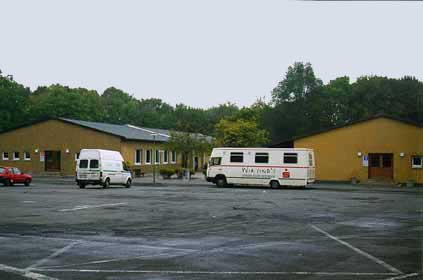Entrance to Buchenwald concentration camp The photo above shows the parking lot for the Buchenwald Memorial Site on the grounds of the former concentration camp. The four yellow buildings are barracks where the SS guards lived when Buchenwald was a prison camp for political prisoners. In the middle of the four SS barracks is a space where a fifth building was torn down. These SS barracks were built between 1937 and 1939; the parking lot is the former SS parade ground. There were originally 18 of the barracks, arranged in a semi-circle around the parade ground; each barrack housed 100 SS men. One of the former SS barrack buildings has been turned into a youth hostel with accommodations for 35 people. It is available for groups of young people, teachers, associations and other interested persons for seminars and for week-long projects. SS stands for Shutzstaffel, the name for the elite soldiers who were originally Hitler's body guards, but later became the concentration camp guards. There was another group called the Waffen SS, which fought in battle in separate divisions from the Wehrmacht, the regular German Army. The SS wore black uniforms and a death's head or skull emblem on their caps. The SS and the concentration camp system were so closely connected that the title of the first book about Buchenwald was "Der SS-Staat," written in 1946 by Eugen Kogon, an Austrian Social Democrat who was sent there because he was a political activist. This book was a rewrite of the Buchenwald Report compiled by the US Army from interviews with the survivors. The city bus that goes to the camp stops in the parking lot in front of the book store/information center and another building which has a cafeteria and rest rooms. In the photo below, the book store and tourist information center is on the left and the cafeteria is on the right.   A 30-minute movie, entitled O Buchenwald, was being shown in the information center at 11 a.m. and again at 2 p.m. when I visited in 1999. The entrance to the theater is on the right hand side of the building. The movie, which was entirely in German, featured elderly survivors who were telling stories about the camp. There were no pictures of emaciated camp survivors, nor any piles of emaciated corpses. This film showed liberated prisoners who appeared to be in good condition, including a chubby cheeked four-year-old boy nicknamed Yushu, who was the youngest of 904 survivors of the Buchenwald Children's Barrack. The only indication of hardship in the camp, as shown in this film, was one liberated prisoner who had very skinny legs. Some of the film's footage was taken by the Nazis; one of the speeches of German propaganda minister Josef Goebbels was shown, as well as a Hitler speech at a Nazi rally at Nürnberg. Home |